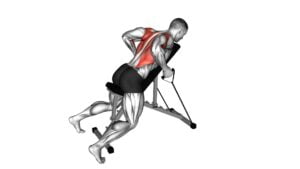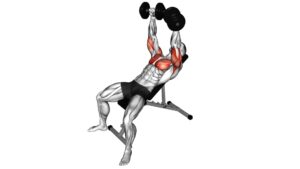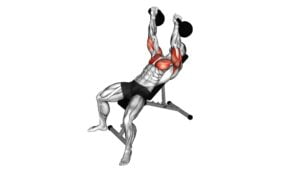Band Incline Bench Press – Video Exercise Guide & Tips

Looking to level up your chest workout? The band incline bench press is a must-try exercise. In this video exercise guide, we'll show you how to properly set up and execute this move for maximum gains.
Watch This Exercise Video
Whether you're a beginner or advanced lifter, we've got variations and modifications to suit your fitness level. Avoid common mistakes and learn tips for progression to increase the intensity.
Get ready to sculpt your chest like never before!
Key Takeaways
- Band incline bench press targets and strengthens upper body muscles using resistance bands.
- It engages more muscle fibers for greater muscle activation and development.
- The exercise primarily works the chest, shoulders, and triceps, with an emphasis on the upper chest muscles.
- Proper setup and equipment, such as an adjustable incline bench and resistance bands, are essential for a safe and effective workout.
Benefits of the Band Incline Bench Press
Experience the numerous benefits of the Band Incline Bench Press. This exercise utilizes band resistance to target and strengthen your upper body muscles. By incorporating resistance bands into your incline bench press, you can enhance the effectiveness of the exercise and maximize your upper body strength gains.
One of the primary benefits of the Band Incline Bench Press is the added resistance provided by the bands. As you press the weights up, the bands stretch, creating tension that challenges your muscles throughout the entire range of motion. This constant tension not only increases the difficulty of the exercise but also engages more muscle fibers, leading to greater muscle activation and development.
Another advantage of the Band Incline Bench Press is its ability to target specific muscles in the upper body. This exercise primarily works the chest, shoulders, and triceps, helping to build strength and definition in these areas. Additionally, the incline bench angle places more emphasis on the upper chest muscles, allowing for more comprehensive upper body development.
Incorporating the Band Incline Bench Press into your workout routine can lead to significant improvements in upper body strength. By utilizing band resistance and targeting specific muscle groups, you can enhance the effectiveness of this exercise and achieve your fitness goals more efficiently.
Proper Set-Up and Equipment Needed
To properly set up for the band incline bench press, start by positioning the bench at a 45-degree angle.
Make sure you have the essential equipment, including resistance bands and a barbell or dumbbells.
It's important to take safety precautions and consider factors such as the weight of the bands and your own strength level to ensure a safe and effective workout.
Correct Bench Positioning
You should position yourself correctly on the bench and ensure that you have the proper set-up and equipment. Here are some tips for correct bench positioning:
- Adjust the incline bench to a comfortable angle, usually between 30 to 45 degrees.
- Position yourself on the bench with your feet firmly planted on the floor, shoulder-width apart.
- Lie down on the bench with your head, upper back, and glutes in contact with the bench.
Common mistakes to avoid include:
- Arching your back excessively, which can strain your lower back.
- Placing your feet too far forward or too far back, which can affect your stability and form.
- Failing to use a spotter or safety bars, especially when using heavy weights.
To progress in your band incline bench press, gradually increase the resistance of the bands or increase the number of bands used. Always focus on maintaining proper form and technique throughout the exercise.
Essential Equipment for Setup
Now let's delve into the essential equipment needed for proper set-up of the band incline bench press.
To perform this exercise, you'll need an adjustable incline bench and resistance bands. The resistance bands provide the necessary band tension, making the exercise more challenging and effective. It's important to choose bands with appropriate tension for your strength level.
You can modify the exercise by adjusting the band tension or using different bands to target specific muscle groups. Additionally, you may choose to use a barbell or dumbbells for added resistance. These equipment options allow for customization and progression as you advance in your fitness journey.
Now that you know the essential equipment needed, let's move on to safety precautions and considerations.
Safety Precautions and Considerations
Ensure proper set-up and equipment to safely perform the band incline bench press. Taking safety precautions and considering injury prevention is crucial when engaging in any exercise. Here are some important points to keep in mind:
- Proper form: Maintain proper body alignment and technique throughout the exercise to minimize the risk of injury.
- Spotter: Have a spotter present to assist you during the exercise, especially when using heavier resistance bands.
- Sturdy equipment: Make sure the bench and bands are secure and in good condition, preventing any accidents or equipment failure.
By following these safety precautions and considerations, you can reduce the risk of injuries and ensure a safe and effective band incline bench press workout.
Remember to always prioritize safety and listen to your body's signals during exercise.
Step-by-Step Execution of the Exercise
To begin executing the Band Incline Bench Press exercise, position yourself on an incline bench. Ensure that the bench is set at an angle of around 30 to 45 degrees. Place your feet firmly on the ground and your back flat against the bench. Grasp the handles of the resistance bands and extend your arms straight up, directly above your chest. This will be your starting position.
As you lower the bands, bend your elbows and bring the handles towards your chest. Keep your elbows tucked in and your wrists straight. Slowly press the bands back up to the starting position, fully extending your arms. Remember to maintain control throughout the movement and breathe evenly.
Common mistakes to avoid during this exercise include arching your back excessively, using momentum to lift the bands, and allowing your elbows to flare out. To modify the exercise, you can adjust the angle of the incline bench or use different resistance bands to increase or decrease the intensity. Additionally, you can perform the exercise with dumbbells instead of resistance bands for a different variation.
Always consult a fitness professional before attempting any modifications or variations to ensure proper form and safety.
Common Mistakes to Avoid
To ensure you perform the band incline bench press correctly, there are a few common mistakes you should avoid.
First, make sure you have the correct grip width, as gripping too wide or too narrow can compromise your form.
Additionally, be mindful of arching your back excessively, as this can put unnecessary strain on your lower back.
Lastly, avoid lifting too heavy weights that you can't handle, as this can lead to improper form and potential injury.
Incorrect Grip Width
When gripping the bar for the band incline bench press, be careful not to hold it too wide or narrow. Incorrect hand placement can lead to ineffective workouts and potential injuries. To ensure proper grip technique, keep these tips in mind:
- Find the right width: Place your hands slightly wider than shoulder-width apart on the bar. This allows for optimal stability and control during the exercise.
- Avoid extreme widths: Holding the bar too wide can strain your shoulders and put unnecessary stress on your wrists. Conversely, gripping it too narrow may limit your range of motion and decrease the effectiveness of the exercise.
- Experiment and adjust: Everyone's body is different, so it's important to find a grip width that feels comfortable and allows you to perform the exercise with proper form and technique.
Arching Back Excessively
Avoid excessive arching of your back during the band incline bench press to prevent potential injuries and maintain proper form. Overarching form can put unnecessary strain on your lower back and increase the risk of injury.
When performing the exercise, focus on keeping your back in a neutral position, with a slight natural arch. Engage your core and maintain a stable position throughout the movement.
Excessive arching not only puts stress on your back but also limits the effectiveness of the exercise by taking away tension from the target muscles.
Lifting Too Heavy
If you lift too heavy during the band incline bench press, you risk compromising your form and increasing the likelihood of injury. It's crucial to maintain proper form throughout the exercise to target the intended muscles and minimize the risk of strains or muscle imbalances. Here are some common mistakes to avoid when lifting too heavy:
- Using improper form: When the weight is too heavy, it becomes tempting to sacrifice form to complete the exercise. This can lead to injuries and decrease the effectiveness of the exercise.
- Overtraining risk: Lifting too heavy without allowing sufficient recovery time can increase the risk of overtraining. It's important to listen to your body and give it enough time to rest and recover between workouts.
By avoiding these mistakes, you can safely and effectively perform the band incline bench press.
Now, let's move on to discussing variations and modifications for all fitness levels.
Variations and Modifications for All Fitness Levels
Try incorporating variations and modifications into your Band Incline Bench Press routine to cater to different fitness levels. By making these adjustments, you can ensure that the exercise is challenging yet achievable for everyone.
For beginners or those with limited upper body strength, using a lighter resistance band or no band at all can be a good modification. This allows you to focus on mastering the proper form and technique before progressing to heavier bands. Another variation is to perform the exercise on a flat bench instead of an incline bench. This reduces the difficulty level and puts less stress on the upper chest muscles.
On the other hand, if you're looking to increase the intensity of the Band Incline Bench Press, there are several variations you can try. One option is to use a heavier resistance band or multiple bands to provide more resistance. You can also incorporate pauses at the bottom or top of the movement to challenge your muscles even further. Additionally, performing the exercise at a slower tempo or increasing the number of repetitions can also increase the overall difficulty.
Tips for Progression and Increasing Intensity
To continue building strength and challenge yourself further in the Band Incline Bench Press, there are effective tips for progressing and increasing intensity. Here are some progression tips and intensity increase techniques to take your workout to the next level:
- Gradually increase the resistance bands: Start with a lighter band and gradually increase the resistance as you get stronger. This will help you continue to challenge your muscles and build strength over time.
- Increase the incline angle: As your strength improves, try increasing the incline of the bench. This will shift the focus onto your upper chest and shoulders, providing a greater challenge and allowing for further progression.
- Add more sets and reps: Once you have mastered the exercise with a certain number of sets and reps, try adding more to increase the intensity. This could mean adding an extra set or increasing the number of reps per set.
By implementing these progression tips and intensity increase techniques, you can continue to challenge yourself and see improvements in strength and muscle development.
Remember to listen to your body and progress at a pace that's comfortable for you, gradually increasing the intensity as you become stronger and more confident in your abilities.
Frequently Asked Questions
How Many Sets and Reps Should I Do for the Band Incline Bench Press?
To determine the number of sets and reps for the band incline bench press, you should consider your fitness goals and current level of strength. Generally, it's recommended to perform 3-4 sets of 8-12 reps for muscle growth and strength development. However, you can vary the number of sets and reps depending on your preferences and abilities.
The band incline bench press offers variations such as using different band tensions to increase resistance and target specific muscle groups. It also provides benefits like improved upper body strength and stability.
Is It Safe to Use Heavy Resistance Bands for This Exercise?
Using heavy resistance bands for the band incline bench press has its pros and cons.
The benefit is that it increases the resistance, making the exercise more challenging and helping to build strength.
However, there are also risks involved. Using heavy resistance bands can put more strain on your muscles and joints, increasing the risk of injury if not done properly.
It's important to use proper form and start with lighter resistance bands before progressing to heavier ones.
Can I Use a Regular Bench Instead of an Incline Bench for This Exercise?
Yes, you can definitely use a regular bench instead of an incline bench for this exercise. While the incline bench press specifically targets the upper chest muscles, using a regular bench will still allow you to work your chest muscles effectively.
However, keep in mind that the angle of the bench will affect the intensity and muscle activation. If you're looking for alternative exercises, you can try dumbbell incline press or push-ups with your feet elevated on a bench.
What Muscles Does the Band Incline Bench Press Primarily Target?
The band incline bench press primarily targets your chest muscles, specifically the pectoralis major and minor. This exercise also engages your anterior deltoids (front shoulder muscles) and triceps.
The use of resistance bands adds an extra challenge to the exercise, helping to strengthen and tone your chest and upper body.
Additionally, the band incline bench press can improve overall upper body strength, enhance shoulder stability, and increase muscle endurance.
Are There Any Specific Breathing Techniques I Should Follow During This Exercise?
During the band incline bench press, it's important to follow specific breathing techniques. Proper breathing can help you maintain stability and maximize your performance.
As you lower the weight, inhale deeply, filling your lungs with air. On the way up, exhale forcefully, engaging your core and generating power.
Conclusion
In conclusion, the band incline bench press is a highly effective exercise for targeting the upper chest muscles. By using resistance bands, you can increase the intensity and challenge of the movement.
Proper set-up and execution are key to maximizing the benefits and avoiding common mistakes. Remember to start with a suitable weight and gradually progress to higher resistance levels.
With consistency and proper form, you can achieve great results and improve your overall upper body strength.

Author
Years ago, the spark of my life’s passion ignited in my mind the moment I stepped into the local gym for the first time. The inaugural bead of perspiration, the initial endeavor, the very first surge of endorphins, and a sense of pride that washed over me post-workout marked the beginning of my deep-seated interest in strength sports, fitness, and sports nutrition. This very curiosity blossomed rapidly into a profound fascination, propelling me to earn a Master’s degree in Physical Education from the Academy of Physical Education in Krakow, followed by a Sports Manager diploma from the Jagiellonian University. My journey of growth led me to gain more specialized qualifications, such as being a certified personal trainer with a focus on sports dietetics, a lifeguard, and an instructor for wellness and corrective gymnastics. Theoretical knowledge paired seamlessly with practical experience, reinforcing my belief that the transformation of individuals under my guidance was also a reflection of my personal growth. This belief holds true even today. Each day, I strive to push the boundaries and explore new realms. These realms gently elevate me to greater heights. The unique combination of passion for my field and the continuous quest for growth fuels my drive to break new ground.



